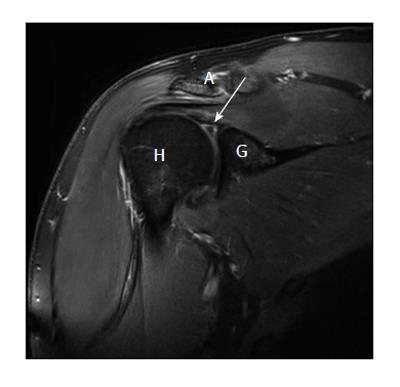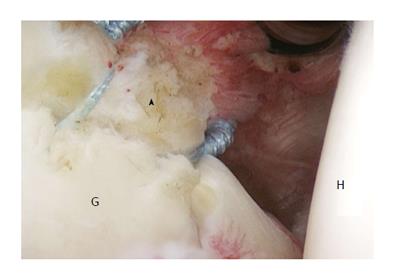Copyright
©The Author(s) 2015.
World J Orthop. Oct 18, 2015; 6(9): 660-671
Published online Oct 18, 2015. doi: 10.5312/wjo.v6.i9.660
Published online Oct 18, 2015. doi: 10.5312/wjo.v6.i9.660
Figure 1 Superior labral anterior posterior classification.
A: SLAP I lesion: Degenerative fraying of the superior labrum; B: SLAP II lesion: Detached labro-bicipital complex; C: SLAP III lesion: Bucket-handle tear; D: SLAP III lesion: Bucket-handle tear with extension to the biceps tendon. SLAP: Superior labrum anterior posterior.
Figure 2 Superior labral anterior posterior II lesion: Findings in direct magnetic resonance arthrography.
A: The coronal oblique fat saturated image (cor pd tse fs) shows the detached labro-bicipital complex from the upper rim of the glenoid. The tear is marked by the arrow; B: The transverse fat saturated magnetic resonance arthrography-image (tra pd tse fs) reveals the slight runnel of contrast agent between superior labrum (arrowhead) and glenoid. A: Acromion; H: Humeral head; G: Glenoid.
Figure 3 Superior labral anterior posterior III lesion: Findings in direct magnetic resonance arthrography.
The coronal T1-weighted (cor t1 tse fs) fat-saturated image shows the separated triangle (arrow) of the bucket-handle without instability of the labro-bicipital complex. A: Acromion; H: Humeral head; G: Glenoid.
Figure 4 Superior labral anterior posterior I lesion: Intraoperative findings in shoulder arthroscopy (posterior-anterior view from the posterior portal of a right shoulder).
A: A degenerative fraying of the superior labrum could be detected by diagnostic arthroscopy; B: After debridement of the superior labrum, a sublabral recess appears. The presence of a type II SLAP lesion should be excluded; C: A more detailed demonstration of the sublabral recess (arrowhead) with smooth lining without instability of the labro-bicipital complex. LBC: Labro-bicipital complex; H: Humeral head; G: Glenoid; SLAP: Superior labrum anterior posterior.
Figure 5 Superior labral anterior posterior II lesion: Intraoperative findings in shoulder arthroscopy (posterior-anterior view from the posterior portal of a left shoulder).
A: Intraoperative aspect of a non-displaced SLAP II lesion (arrowhead); B: Verifiction by inserting a probe; C: SLAP repair by a single stich posterior to the biceps tendon. LBC: Labro-bicipital complex; H: Humeral head; G: Glenoid; SLAP: Superior labrum anterior posterior.
Figure 6 Superior labral anterior posterior II lesion: Intraoperative findings in shoulder arthroscopy (posterior-anterior view from the posterior portal of a right shoulder).
First step in mini-open tenodesis is an arthroscopic tenotomy of the biceps tendon (arrowhead) and reattachement of the superior labrum. H: Humeral head; G: Glenoid.
Figure 7 Mini-open biceps tenodesis: The red tagged part of the biceps tendon is resected.
An extra-anatomical fixation is performed above the upper border of the tendon of the great pectoral muscle.
- Citation: Popp D, Schöffl V. Superior labral anterior posterior lesions of the shoulder: Current diagnostic and therapeutic standards. World J Orthop 2015; 6(9): 660-671
- URL: https://www.wjgnet.com/2218-5836/full/v6/i9/660.htm
- DOI: https://dx.doi.org/10.5312/wjo.v6.i9.660















